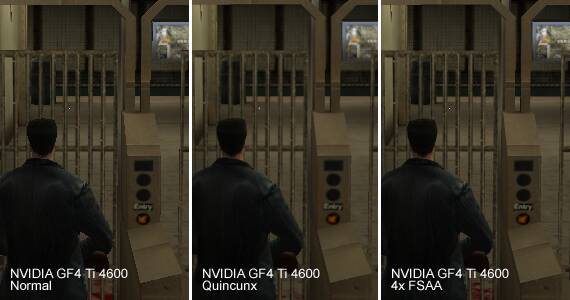Attack Out Of The Blind Spot: Matrox Parhelia-512
FSAA Rendering Quality
To put it simply, the latest graphics cards have two separate 3D drivers: one for Direct 3D and one for OpenGL. Of course, this is also true for anti-aliasing. In the past, NVIDIA's graphics cards achieved very good frame rates under OpenGL, but broke down in Direct 3D. Ever since the newest generation of drivers and the introduction of the GF Ti models, this has been remedied. This example shows you why Direct 3D and OpenGL must be analyzed separately.
Matrox's new Fragment Anti-Aliasing technology (16x FAA) (http://www6.tomshardware.com/graphic/02q2/020514/parhelia-05.html) introduces a whole new factor, because, unfortunately, this mode doesn't work with all games. Under certain conditions, with the use of stencil buffers, for example, this mode is unable to find the edges of the objects. In this case, Parhelia must make use of the very slow 4x SuperSampling mode.
The following gives you a quality comparison in Max Payne:

Click here for an uncompressed version of the screenshot.
Parhelia's 16x FAA mode does not find all of the edges in this game. Good ol' "Max" is indeed freed of his rougher edges, but the objects surrounding him, such as the ticket scanner, for instance, are rendered without anti-aliasing. In SuperSampling mode, however, all objects are filtered. It's interesting to note that the back part of the train station becomes much more clearly rendered in SuperSampling mode.
And now, on to the GeForce 4, where we use the Quincunx and 4x FSAA modes:

Click here for an uncompressed version of the screenshot.
Get Tom's Hardware's best news and in-depth reviews, straight to your inbox.
With NVIDIA's various FSAA modes, all areas of the image are always filtered, so you don't have the problem of edges getting left out of the calculation. The image in the middle shows the Quincunx mode, where NVIDIA tries to attain 4x quality at 2x performance through a few tricks. However, the anti-aliasing comes at the cost of significant blurring, which is quite noticeable in the background of the image, as well as the word "Entry." At 4x, these objects are much sharper.
In Quake 3, by contrast, Parhelia's 16x Fragment mode leaves no room for complaint. The following shows a quality comparison:

Click here for an uncompressed version of the screenshot.
The differences between NVIDIA's Quincunx and 4x modes are marginal. It's only when you look very closely at the image that you can perceive any differences, since the blurriness that is typical for Quincunx mode does not have a big effect on this portion of the image. The advantage of Parhelia's Fragment mode, however, becomes all too clear. The jagged edges look much smoother, even at the first fleeting glance.
The conclusion in the area of quality definitely points in favor of Parhelia. Still, Matrox has some explaining to do as to why 16x FAA does not function properly in Max Payne.
And now for the second part of the comparison: anti-aliasing performance.
Current page: FSAA Rendering Quality
Prev Page Anisotropic Filering Performance, Continued Next Page Anti-aliasing Performance